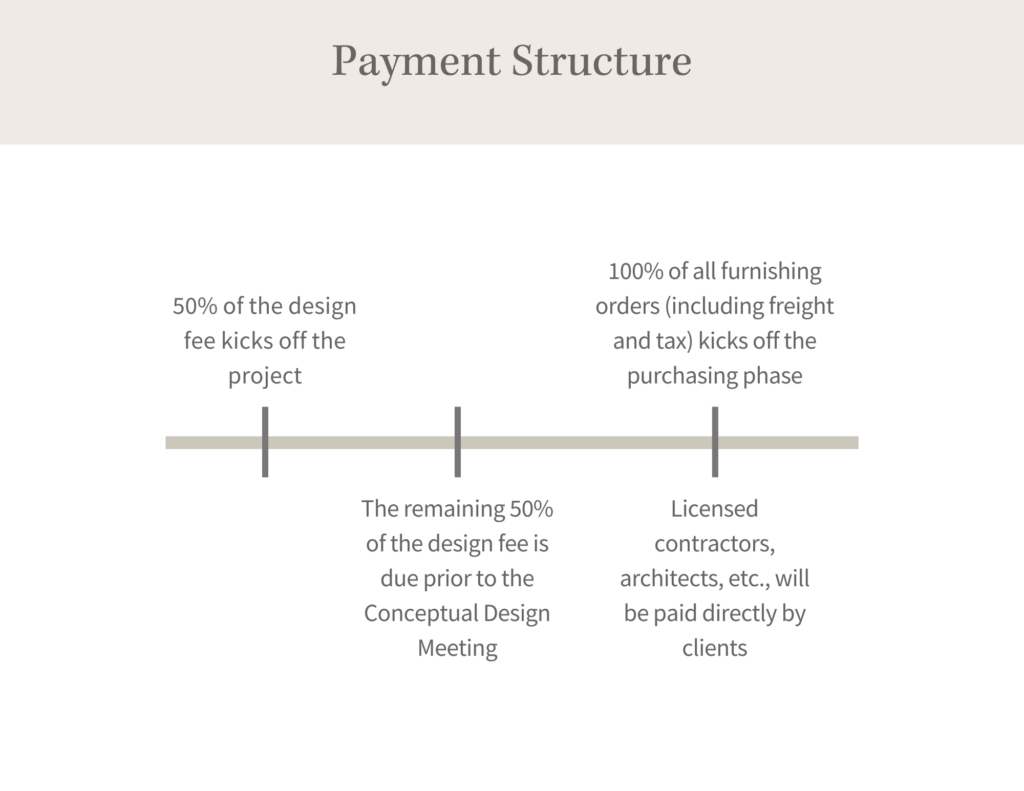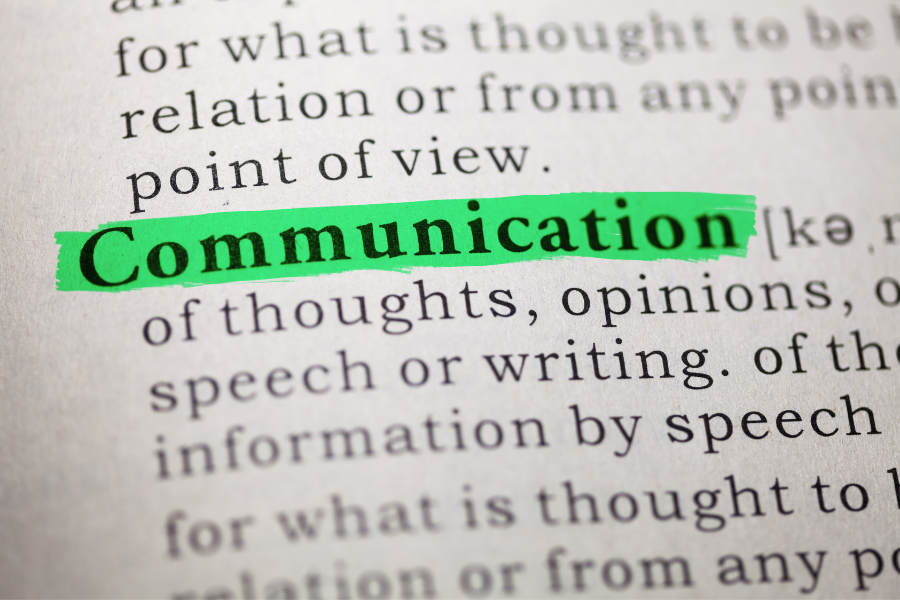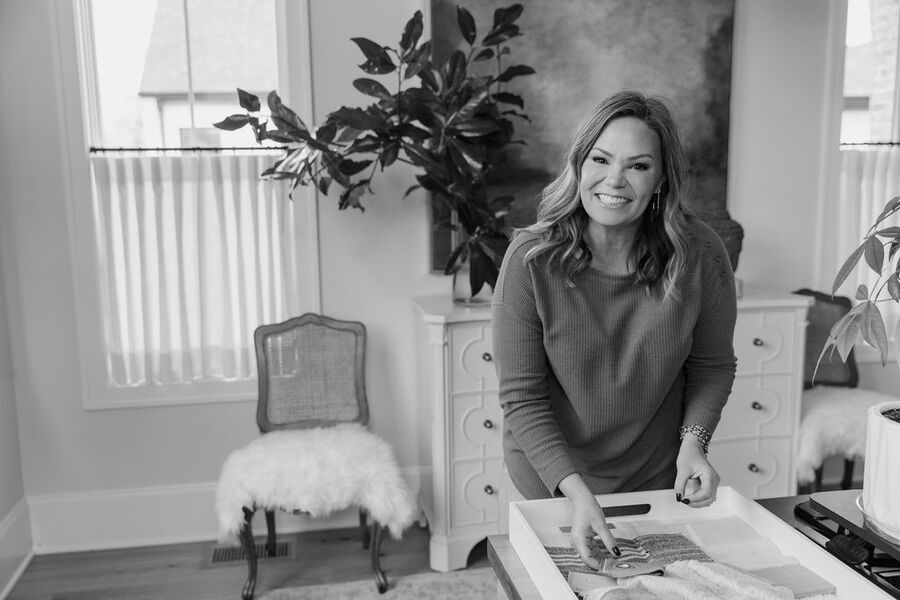You can be as confident about your interior design pricing, process, and business model as you are about your designs.
You’re in business for profit. Otherwise, it’s a hobby. Your interior design pricing needs to take care of you and compensate you for your time, effort, aesthetic, and the brilliance that you bring to each project.
But, where to start? You deserve an interior design pricing model that completely covers you and your business.
Once you understand these interior design pricing principles, everything inside of your business will shift.
Imagine being 100% confident in your interior design pricing—so confident that you’d never even consider negotiating. You go into every pitch with unwavering, immovable certainty. Your ideal clients will be signing on and you’ll be making great money while building an amazing business.
Here’s what I’ll cover on interior design pricing:
- Leave Hourly Billing Behind
- The Benefits of Charging a Flat Fee
- Past Project Data
- Get Paid In Full Upfront – Yes, you can!
- You’re Worth More Than Your Time
- Cover Your Booty
- Build a Luxury Experience for Your Clients
- Be “Transparent” and Never, Ever Share Your Discount
- How to Raise Your Rates
- How to Address Rate Increases with Existing Clients
- Plan for Rejection
- Eliminate the Legwork – There’s a better way…
Let’s dig in, shall we?
Leave Hourly Billing Behind
We can’t talk about interior design pricing without addressing hourly billing. Early in my career, I hated talking numbers. I wasn’t confident in my interior design pricing and I found myself negotiating and second-guessing everything. Clients found my hourly interior design pricing vague, even though I have a finance degree and worked as a business process consultant.
When I was charging hourly, I was working my booty off and I didn’t have much to show for it. I had a lot of money coming in the front door and a lot of money going right out the back.
There had to be a better way.
Then I had an incredible, high-end repeat dream client tell me, “I don’t want to be nickeled and dimed” (after I continually bombarded him with invoices).
Rude in the moment? Yeah, completely. But it was the interior design pricing lesson I needed to learn.
This client appreciated and valued my design skills and had the money to pay for it, but he didn’t want to be constantly searching for his checkbook or his login or dealing with all these invoices.
Our clients are just as busy as we are.
If you’ve ever been working on a design project and the client is suddenly interested in “taking it from here”, they’re probably starting to feel weighed down by all the time bills.
This happened to me time and time again, back when I was charging hourly. And, even if I was giving a realistic estimate of what my services would cost for the scope of work… the client continued to watch the clock, especially the further we got into the project.
You see, they were only committed to me as far as the next invoice. And, I haven’t met an hourly client yet who didn’t think they’d spend less than my estimate… which doesn’t go over well when it is, in fact, accurate.
It was time to transition to a flat fee interior design pricing model.
The Benefits of Charging a Flat Fee

I figured out an interior design pricing model that allows you to confidently price your services for high-end clients so that you are both abundant and adored.
By changing my interior design pricing model to a flat design fee, I now give my clients all of the information on what their project is going to cost them upfront. This includes the cost of my design fees and the estimated total they can expect to spend on furnishings.
Your client should always get the full picture of what their financial investment will need to be to get their project done from start to finish (and looking like your beautiful portfolio images) before you take them on as a client.
Going from an hourly to a flat-fee interior design pricing model has not only saved me so much strife over the years but it’s made me exponentially more profitable.
How? Because I only take on clients that are on board with my design fee. Unlike hourly, they don’t think, hope, and wish that it will actually be less. It is what it is—paid upfront.
Also, I get to see all projects through to completion. No one is firing me mid-project to save a few bucks and not allowing me to see my vision through (or get portfolio images). When they pay upfront, in full, clients are thrilled to have your oversight through the entire project.
“But how do you come up with a flat fee interior design pricing model?”, you ask.
Three little words…
Past Project Data
Numbers don’t lie. Use past project data to determine your interior design pricing. If you don’t have past project data, start collecting it now.
When you use past project data to project what the future is going to be for your current projects, you’re able to provide the full project estimate upfront, including the design fee and the furnishings budget (and freight!)
You are the expert. You have to be able to give these estimates at the front end of projects so that your client knows if they want to get involved in this project at that number.
If you need more help getting your head around flat fees, I cover this, in depth, inside my business template for designers, the Interior Design Standard. My proven process includes an interior design pricing calculator to price entire projects (fees and budgets) in minutes before you design a thing, which designers and clients love.
Get Paid In Full Upfront – Yes, you can!

Yes, that’s right… be paid in full before you present any of your design ideas.
Our interior design pricing timeline is as follows: Collect 50% of your design fee when you sign the agreement and then the remaining balance before the first design presentation.
Design is intellectual property and once you present your ideas, you can never take them back. That is your expertise. That is your wisdom. That is the thing that you can’t put a price on because it comes from project after project and all of your experiences. So make sure that you get paid in full before you deliver.
Also, of course, you’re going to collect 100% payment for furnishings before you order a thing. Tax and freight included. I love to wrap up a project with no freight invoices at the end. Who wants to end a project with a whole bunch of freight bills? That’s no fun.
You’re Worth More Than Your Time
Another benefit of flat fee interior design pricing is the ability to charge your worth. When you charge hourly for your time, you take away the ability to include your natural talent, your eye for design, and that trip you took to France where you just took in so much culture and such an understanding of nuance and scale and age and beauty.
You’re taking away all the mentors and all the time you’ve spent and every book you’ve ever read on design, the history of furnishings, right? All of those things take time to cultivate and add value to your interior design services.
Separate your worth from the time it takes you. You continue to get more and more efficient with each project—so hourly does not serve you in the long run.
As my rate naturally went up over the years, I watched my clients become more and more fixated on analyzing invoices and watching the clock at meetings. That’s no way to build a relationship.

Want to be a fly on the wall?
Sign up below to download my exact Sales Presentation:
Cover Your Booty
Another amazing thing about a flat fee interior design pricing model is that you can build in all of the things that you want to create… all of the extras, all of the details, all of the “what ifs” that go into making your design sing.
You’re also going to build in the inevitable things that happen every single project. A scratch, a nick, a delay, an issue (you know, all those “fun” things that make up the punch list).
Coming to the rescue of any project costs money.
And instead of “nickel and diming” my clients with invoices I’m now building in “oh shit money”. I’ve done enough projects that I understand that I need to add a percentage just to make sure that I can cover the “what ifs” of the project.
When you build all of that into your interior design pricing, you avoid bombarding your clients with tiny invoices or change orders (or worse, just eating the cost) and instead get to be the hero of the day.
Build a Luxury Experience for Your Clients
Your interior design pricing model should also allow you to create a truly memorable, custom, luxury experience for every one of your clients. That may mean paying attention to what they order or asking them outright in your intake process… and then having their favorite snacks or drinks at your next meeting.
You want to build all of that into your interior design pricing. It is really, truly the ultimate luxury experience.
All-in, upfront paying is like flying first class. You’re super excited and delighted by being able to board first and having plenty of headspace. And of course, there’s that tray coming around with complimentary champagne before you even sit in your seat and they just keep coming.
And as much as you love it, you know that your ticket price far exceeded that champagne. But you’re getting the full experience.
When you price in all the little perks… when you go the extra mile and say, “I want to be on the job site for every install, I want to be on-site weekly.” Price it in.
“I want to have a little wiggle room. I want to be able to send flowers if the client has a life event.” Price it in.
“I want to have an assistant with me at big design presentations to take notes while I’m working the room.” Price it in.
When you think through the experience that you want to create and you price it in, it feels amazing. It feels like first class. It feels like bottomless champagne to your clients. They’ve made the decision that they want to work with you.
They’ve opted for the price point that you’re offering. Now you get to shower them with delight.
Charge a flat fee, but build in all the “what ifs”, the bougie experience, and all the time that you want to spend on this project. Clients are not afraid of a big number if they’re going to get amazing results. A gorgeous home that reflects them, that’s in their aesthetic.
You’re going to take all the project management off of their plate. You’re going to spoil them rotten throughout the project, you’re going to communicate to them constantly and their home is going to look like one of the homes in your portfolio at the end. It’s well worth the effort to move to that kind of flat-fee interior design pricing.
And, of course, it’s all these extras—the surprise and delight—that get your clients talking and referring. I can’t stress this extra benefit enough.

Be “Transparent” And Never, Ever Share Your Discount
I walked into a potential client site many, many moons ago. The client was interviewing lots of designers and was very checked into our industry. So her question was, “Do you pass along your trade discount”?
I turned to her and I said, “No, I don’t… that’s the part that makes this a business.”
I smiled and kept walking the space. She laughed out loud and we just kept going. I got the job and completed a beautiful design project.
So, the bottom line is, it’s the tone with which you respond is most important when discussing your interior design pricing and why you don’t pass on your discount. Own the transparent fact that you’re in business for profit.
Honestly, I may get that tattooed on me… “In Business 4 Profit” and proud of it!
No other industry struggles with this concept. We are given trade pricing so we can resell the goods and profit from the difference before purchase and sale price. That’s it. So simple.
So, like most industries, there’s never a time when a client would be privy to my purchasing power and the relationships that I’ve cultivated with vendors.
When you are that clear and you are that frank, the potential client is either in or out.
You have to be transparent about your interior design pricing and keep it simple throughout the potential client process. Only working with clients that value you to the level that you require to be a profitable, joyful, enthusiastic business.
How to Raise Your Rates
My husband always says to me, “If you are signing all the potential clients that you meet with, then your interior design pricing is too low, right?” Basic economics. You’re not supposed to be signing every single potential client you meet.
So, look at your metrics. Are you profitable? Are you making enough?
If you’re getting to the point in your career where you need to hire, need an office space, need a library, need to start traveling to markets to get better vendors… there is some actual leveling up going on inside your business that requires a rate increase, right?
Look back at all the potential clients you’ve met with and how many you’ve signed—you have that inner knowing, you know it’s time to raise those rates.
How to Address Rate Increases with Existing Clients

Whether it be from hourly to flat fee or a simple rate change, it’s important to communicate your new way of working to existing clients.
There’s an email template inside the Interior Design Standard that our members love to use when transitioning their interior design pricing model for existing clients. It explains that to provide the absolute top-quality service that I can to my clients, to make sure that my business is locked down and that I’m properly insured, I need to level up my business.
When I raised my rates I also went from an hourly rate to a flat-fee interior design pricing model so I also let them know I’m shifting how I’m working. This could sound like:
“I’ve been listening to my clients and from now on you’ll be seeing a flat fee to work with me. You’ll know exactly what I’m going to cost upfront (no more wondering how much this is going to cost you).”
And while I absolutely appreciate my client’s business, things shift! It’s completely up to them if they’d like to come on board or not.
Yes, you’re going to finish out existing projects at whatever rate is under contract. Then, if those clients add scope or want to do another project with you, you’re going to put them through a rate increase protocol.
As part of this communication, consider including the improvements that you’ve made in your business. For instance
“I have a very high caliber new lead designer on staff, we’ve invested in new equipment, we’ve upgraded our AutoCAD…”
These are all things that are valuable to your clients so go ahead and point out the changes that you’re making or have made and then address the fees in accordance with those improvements.
Plan for Rejection
Rejection is part of the gig. Plan for it. Plan your reaction to it and prepare your face not to falter and fall apart when someone says, “Whoa, that’s way more than I was thinking”. Plan what you’re going to say to that.
Rejection has to be in the plan for you to know that your interior design pricing is the appropriate amount for your marketplace and yourself.
Remember, if you close 100%, your rates are too low. Follow your gut.
There is nothing worse than an underappreciated entrepreneur.
If you’re feeling taken advantage of, underappreciated, or not valued—or if you’re constantly telling yourself, “They have no idea how much I put into this”—then you’re charging too little. That resentment isn’t good for your soul, it’s not good for your client relationship, it’s not good for your referrals and it’s not good for your mental health.
So, if you’re walking around with a chip on your shoulder because no one appreciates you, (a.k.a. pays you enough), this is your great big poster board reminder that you are the one who determines your interior design pricing. You’re an entrepreneur, so you determine how much money you make.
How empowering is that? Also, puts you squarely in the driver’s seat. Can’t be stuck in victim mode when we own that we create our own worth. We set our own value.
It’s up to you to decide.
Eliminate the Legwork—There’s a better way…

It’s time to get your business—and your life—in order. I’ve done the legwork on the business part. Your life, that’s up to you.
My program, the Interior Design Standard, hands you everything you need to run a joyful and abundant business: all you have to do is implement.
No homework. Just templates that you download, customize, and implement into your business.
This is the only program that provides a proven interior design pricing model, tons of business templates, and my turnkey, step-by-step processes for executing interior design projects. Plus, the strategy and tangible methods behind attracting and retaining ideal clients.
I was hesitant when I transitioned from hourly to flat fee, but after sitting down with three experts, I created the entire model with my flat fee calculator and design agreement that outlines all the necessary boundaries and expectations to keep a flat fee profitable. As well as my process templates to ensure that you are efficient as you move through projects.
I added all of it to the Interior Design Standard so that you can confidently price your services for ideal clients.
Discover what it feels like to have total confidence in your interior design pricing. I’ll share my secret weapon for delighted clients and a financially thriving business. It’s an all-encompassing process for pricing projects, how to position the fee to clients, when to take payment, how to handle an increase in scope and so much more.
- Price your projects in minutes with the flat fee calculator
- Become the trusted design expert clients are looking for with the design agreement and sales presentation
- Learn how to take control over your finances that will ensure you’re pricing your services for healthy profits
“The Standard is a true game changer. I have the confidence to charge my worth by calculating my flat fee AND estimated furnishings costs for my clients’ projects up front. It takes away ALL the stress by setting those budgets before I start the design process.”
—Kristi Patterson, Grace Hill Design
Tell me in the comments: Now that you have the tools for profitable interior design pricing, what is the first step you will take towards achieving it?

Want to be a fly on the wall?
Sign up below to download my exact Sales Presentation:

